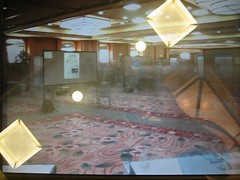Ubi Comp 2006 summary

Time lapse with alpha blending was showing who was looking at what in the demo session…
Attended UbiComp 2006 at Newport Beach, CA. 425 people from 22 countries. 2 days of papers and posters.
Opening keynote by Bruce Sterling who introduced his concept of a SPIME, an object in space and time. He proposed that Ubicomp offers a prime opportunity for delivering sustainability – at its heart it is about understanding the context of stuff in the world around us – we can monitor the environment it is in and how it is used. We can create a system of bits that encapsulate physical atoms of stuff. He presented a diagram showing the lifecycle of SPIMES:
Concepts and designs – google sketchup
Identifying – Unique id – RuBee, rfid, folksonomy
Fabricated – zcorp, MDP realizer
Tracked – Aeroscout
Searched – google, wikiproducts
Recycled – ebay
Data mining – Metadata – everyware, alexa internet archive
The closing keynote by Brenda Laurel was titled Designed Animism. With reference to Aristotle, poetics, narrative, theatre, causality and experience she described the potential of ubicomp to create novel interactive forms. When these new forms are created how will we understand them in terms of structure, causality, narrative and experience. I was reminded suring her talk that mathematics is representing what has been observed in the natural world.
2 tracks of paper. Lots of work being reported on using gsm cells to try and track the location / movement of people *a cheap, lower power consumption alternative to gps*
Eg intel tool at http://www.placelab.org/ see also http://www.placelab.com/ or http://pols.sourceforge.net/
Only downside? The Pigeon blog was unfortunately cancelled because the birds were tired. http://www.pigeonblog.mapyourcity.net/
From presentations:
eBlocks http://www.cs.ucr.edu/eblocks – Extending available electonics building blocks to make it even easier to hack together simple sensor / switch systems. Have simulator system to build systems using drag and drop given a predefined set of components. Simulator can optimise design (ie changing logic based on what physical components are available – 3 logic gate using 2 2 input logic gates – or removing signal inverters by changing logic gate). Can also optimise based on cost of physical eBlocks. Optimisation works on rules based system developed by expert user. Uses simulated annealing to optimise heuristics. Fixed use blocks and programmable blocks available.
Great presentation from Haiyan Zhang on her Masters Thesis Project from Interaction Design Institute Ivrea. She has created a portable / personal games controller by attaching motion sensors to a large pair of crocodile clips which can in turn be attached to anything to turn it into a games controller. More at http://www.failedrobot.com/thesis/
WISP – Joshua Smith (Intel Research) – battery free wireless sensing platform – augments RFID so that in addition to being able to tell what is there you can also check its state – temp, vibration, shock, tampering etc. Work came out of the activity recognition project ARP. Really cool 3 axis accel demo video – since gravity is always an effect on an accelerometer then the axis accel acts as a tilt sensor. Great quote from tesla:
At this Colorado “Experimental Station” Tesla had some early success in wireless power transmission. One photograph shows that “a small incandescent lamp was lighted by means of a resonant circuit grounded on one end, all the energy being drawn through the earth [from a nearby transmitter].” In 1907 he even went as far as to make this statement: “… to make the little filament glow, the entire surface of the planet, two hundred million square miles, must be strongly electrified. This calls for peculiar electrical activities, hundreds of times greater than those involved in the lighting of an arc lamp through the human body [a far more spectacular demonstration]. What impresses him most, however, is the knowledge that the little lamp will spring into the same brilliancy anywhere on the globe, there being no appreciable diminution of the effect with the increase of distance from the transmitter.”
Pasted from <http://www.tfcbooks.com/articles/tws8c.htm>
Links:
Product on the market for measuring energy use in a home: http://www.diykyoto.com/ also see product on offer in NZ at http://www.centameter.co.nz/save-power-new-zealand/centameter-product-info.php
http://www.createascape.org.uk – a tool for creating topographies that you can use to create zones of reference in gps / wifi apps – presented at ubicomp2004
http://www.wigle.net – the database of wifi access points
http://hci.stanford.edu/dtools/ d.tools visual authoring environment using eclipse – includes experimental code to program arduino boards: http://hci.stanford.edu/dtools/arduino.html
http://www.gumstix.com/products.html – gumstix hardware see also community page at: http://www.gumstix.org/
http://zonetag.research.yahoo.com/ from yahoo and flickr geo code your photos – unfortunately on for US and nokia phones…
http://www.particle-computer.net/ and http://particle.teco.edu/devices/index.html from Uni Karlsruhe
Look up gigaprint project http://hci.stanford.edu/gigaprints/ – Paper and digital toolkit available – Mission – The Interactive Gigapixel Prints (GIGAprints) project is an experiment in the future of collaborative workspaces, where printed visualizations are augmented with projectors and mobile devices. We are currently designing, building, and testing the interactions and visualizations that best suit these large paper surfaces.